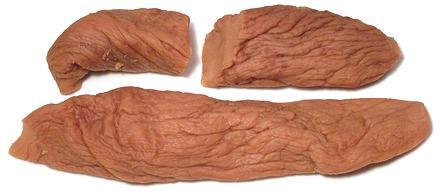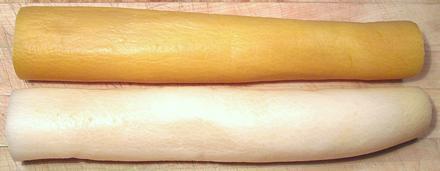In the language of Asian packaging, "Turnip" actually means Daikon Radish. Sometimes there is even further confusion with Mustard Greens. Preserved Radish is sold in two forms, Greens and Roots. Both forms are used in stir-fries.
 These preserved greens are
not pickled, just dried with a whole lot of salt. They need to be rinsed
well before use. Some of my older cookbooks mention them packaged in two
forms, flat leaves or leaves rolled into a ball, both in plastic bags. I
haven't seen the ball form around here, it may have gone out of style, a
relic of the days before plastic bags. In any case, if the recipe calls
for "a ball of chung choy", those balls weighed about 1-1/2 ounces each.
These preserved greens are
not pickled, just dried with a whole lot of salt. They need to be rinsed
well before use. Some of my older cookbooks mention them packaged in two
forms, flat leaves or leaves rolled into a ball, both in plastic bags. I
haven't seen the ball form around here, it may have gone out of style, a
relic of the days before plastic bags. In any case, if the recipe calls
for "a ball of chung choy", those balls weighed about 1-1/2 ounces each.
Salted "Turnip" is popular in stir-fries, giving them a unique and almost smoky flavor. It is generally chopped fine and added near the end of cooking.
This form is extremely salty and needs to be rinsed well before use.
Kept tightly sealed in a cool dry place this form will keep indefinitely
at room temperature. Ingredients: "Turnip", salt, water. Actually the
package the photo sample came in said "Mustard", but the main title says
"Turnip" (mustard greens are generally pickled).

In East Asian packaging the word "Turnip" actually means "Daikon Radish". This form has a different shape from the well known carrot shaped Daikon, and is the whole plant with the greens topped and lesser roots trimmed off. It's been simply preserved in salt, lots of salt, and it needs a good soaking before use.
Because they are so heavily salted, these Daikons may be kept for
months at room temperature so long as they are in a tightly sealed
container so they neither dry out nor absorb moisture. The photo
specimen, purchased from a larg Asian market in Los Angeles (San
Gabriel), was 14 inches long and weighed 2-1/4 pounds. Ingredients:
"Turnip", Salt, Metabisulphate preservative.
 In this form it's much more obvious that
"Turnip" means "Daikon Radish". The photo specimens were packaged as whole
roots but more commonly they are packaged as cut strips. A somewhat shorter,
stubbier variety than the long carrot shaped Japanese daikon is used. This
is a salt fermented pickle which is soft and flexible but retains quite a
bit of crunchiness. Once the vac-pac plastic bag is opened, it should be
kept tightly sealed and refrigerated, where it will keep for
many months. Ingredients: "Turnip", salt, water.
In this form it's much more obvious that
"Turnip" means "Daikon Radish". The photo specimens were packaged as whole
roots but more commonly they are packaged as cut strips. A somewhat shorter,
stubbier variety than the long carrot shaped Japanese daikon is used. This
is a salt fermented pickle which is soft and flexible but retains quite a
bit of crunchiness. Once the vac-pac plastic bag is opened, it should be
kept tightly sealed and refrigerated, where it will keep for
many months. Ingredients: "Turnip", salt, water.
 [Takuan (Japan); Danmuji (Korea)]
[Takuan (Japan); Danmuji (Korea)]
This product is very popular in Japan and Korea as a side dish. In Japan and California it is also used in sushi rolls. The Japanese also have a white daikon pickled in sake with koji culture still in it.
Takuan is, of course, far better tasting and more nutritious when naturally salt fermented, but just about all you can buy around here is factory made, faked up with vinegar and salt. The real Japanese product is a yellowish color, so factory versions are dyed with food coloring - most often an absolutely hideous fluorescent yellow only an Asian could love.
The photo specimens were made in Korea, 12-1/2 inches long and
weighing 1-1/2 pounds each. The ingredients were Radish, Water, Salt,
Vinegar, MSG, Citric Acid, Saccharin, Sodium Bisulphite, and for the
yellow version FD&C Red #40. Why they sweetened with saccharin
instead of sugar is totally beyond me, but these radishes did have
that distinctive saccharine aftertaste.
More on Preserved and Pickled Cabbages.